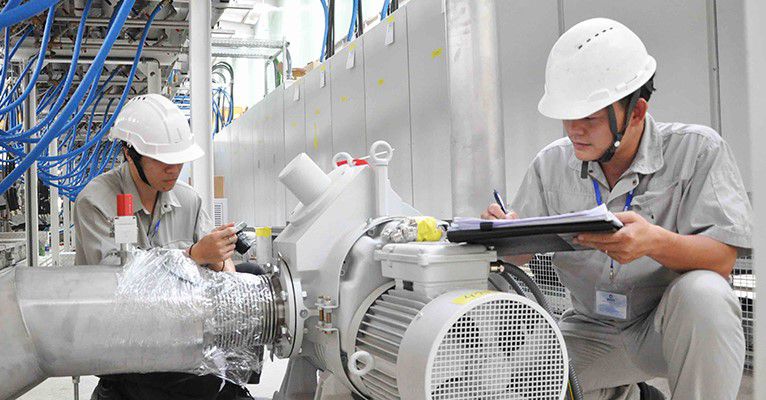During the working process, equipment/machines are affected by the environment and the drift, which over time results in accuracy reduction. Through verification, failures and errors of the equipment can be detected. Then timely measures can be taken to prevent the accident from happening.
1. What is Verification?

Pursuant to the Law on Product and Goods Quality No. 05/2007 / QH12 dated November 21, 2007, Verify means to conduct technical operations in a certain process aimed at assessing and attesting the products or goods satisfaction of the requirements of relevant technical regulations.
Pursuant to the Circular No. 23/2013 / TT-BKHCN dated September 26, 2013 of the Minister of Science and Technology regulating metrology for group 2 measuring instruments, Verification is a measure of controlling measurement carried out by a designated measuring tool verifying organization in order to assess and certify technical measurement characteristics of a measuring device to ensure compliance with technical measurement requirements;
2. Which agency/organization/individual is capable of conducting the verification Verification of measuring equipment
Verification of measuring equipment shall be performed consistently by metrology inspectors according to the
inspection processes. After being verified, if the requirements are met, the measuring equipment will then be affixed with
Verification stamps, or issued with
inspection certificates in measurement by the State management agency or the authorized bodies. The certificate has legal validity throughout the country.
3.What kinds of equipment which need verification

Verification is mandatory for measuring devices included in the "List of equipment required to be verified" under Decision No. 13/2007 / QD-BKHCN dated July 6, 2007 of the Ministry of Science and Technology.
Pursuant to the Circular No.53/2016/TT-BLDTBXH dated December 28, 2016 by the Ministry of Labor, War Invalids and Social Affairs, the required-verification equipments include: machinery, equipment and materials subject to occupational hygiene and safety requirements (Section 1); machinery, equipment and materials used in army subject to occupational hygiene and safety requirements (Section 2).
These equipment generally include those with a high level of risk. When an incident occurs, people, property and the environment are severely affected. For this reason, equipment inspection and registration are needed before being put into use. During use, equipment must be periodically inspected.
If the
verification result is not successful, the equipment won’t be put into practice and must be repaired or replaced and
re-testing until it can meet all requirements to be used.
4. The period of periodic verification for machinery and equipment
Equipment verification period is a specified timeline for the next equipment verification after the first verification.
As a rule, all machinery and equipment, before being put into use, must be inspected and either periodically inspected or abnormally inspected when the equipment is detected to have technical problems that are likely to cause unsafety.
The verification period of the equipment is not the same: equipment verification every 3 years; every 2 years, and annual equipment verification.
The inspection period may be shortened from the initial inspection period based on the use of the equipment, the actual condition at the time of the test, and when the time is shortened, the reason is indicated.
5. Equipment safety verification procedure

Different equipment will have their own specific testing requirements, but generally they undergo the following steps:
- Check records
- Check the equipment (both inside and outside)
- Test durability, sealness
- Check operation
- Make a record of on-site verification.
The inspection procedure will be specified in the technical specification documents (Usually VMI). The inspection will be carried out by specified labs. The Verification results (pass or fail) will be determined by the state inspection agency.
6. Classification of safety verificationThe verification is divided into 3 types:
- First time safety verification: The first time verification will be done after the installation of machinery and equipment to verify that the technical status of the equipment is guaranteed to operate. The inspection results will be certified in written text by the functional unit licensed by the state management agency.
- Periodic safety inspection: This is a regular inspection period. Once the inspection period expires, equipment/ machinery will undergo the inspection again to confirm the technical condition to ensure occupational safety.
- Abnormal safety verification: This is the assessment of the technical safety of machinery and equipment based on the national safety technical regulations that takes place unexpectedly, not according to a certain cycle.
Unusual safety inspection occurs in the following cases:
+ When machines and equipment are repaired or upgraded, the technical or operating processes may be influenced.
+ When changing the installation site of machinery and equipment.
+ For pressure equipment: when temporarily suspended for 12 months, verification is a must before being put into operation again.
+ When requested by the competent management agency or the production and construction unit about re-examining the technical condition of machinery and equipment to ensure occupational safety.
7.The meaning of equipment verification

Verification is needed to ensure safety in social activities. It influences the impact of the product on the environment and nature, and ensures transparency and fairness in trade.
Safety verification is an important task to ensure the safety of both the user and the equipment. Organizations and individuals using equipment, materials and substances with strict requirements on occupational safety and sanitation need to conduct safety verification because:
- Each equipment has its own unique safety standard and requirement. Verification of such equipment is to ensure occupational safety, avoiding unfortunate risks, possible damage.
- Verification is the only way to prove that the equipment meets the technical requirements, meets the requirements of the task.
- Through verification, failures and errors of the equipment can be detected. Then timely measures can be taken to prevent the accident from happening.
- Conducting equipment safety verification is also in compliance with the provisions of the law.






